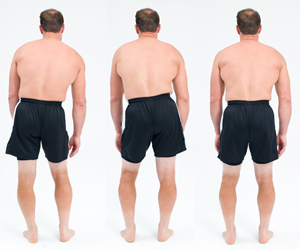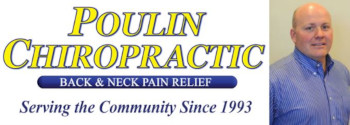About Sciatica, Ashburn and Herndon Leg Pain
Leg pain may not just be pain in the leg. Its source of pain may be the spine.
The clinical term for leg pain is "sciatica." Sciatica is leg pain that originates from the spine and extends down the leg and sometimes into to the foot and toes. Sciatica is the result of slipping of the nucleus pulposus in a contained disc or non-contained disc that results in back pain, and, depending on the severity of the slippage, pain down the leg.
- If the slippage is minimal, your pain may only extend into your buttock.
- If the slippage is a little more severe, the pain may extend into your calf.
- If the slippage is really severe, the pain may extend into your foot and toes.
A thorough, clinical examination that may include imaging is important to your recovery.
The clinical examination of sciatica is vital to the diagnosis of sciatica's source which may be revealed with just a few questions about its symptoms.

Sciatic pain may range from a dull ache to a sharp, stabbing pain. It may be described as burning, numb, pins and needles, tingling, or "worms crawling in the skin." Even the term you choose to describe your pain gives a clinical clue to your doctor of your diagnosis, so explain fully what you feel.
You may find that leaning to one side can alleviate your pain. Leaning into the side of pain, away from the side of pain or just standing "frozen" may reveal where the disc bulge is in relation to the spinal nerve root.

In-office, Poulin Chiropractic of Herndon and Ashburn uses Cox Technic Flexion Distraction and Decompression to lower the pressure in the disc so the nucleus pulposus returns to the center of the disc, aid in the healing of the torn anular fibers, and drive out chemicals that irritate and inflame the spinal nerves.
You must understand that it takes three months for a torn disc to heal well enough to allow you to return to daily activities like prolonged sitting, bending, lifting, twisting, etc. The first three to four weeks of concentrated treatment, therapies, and at-home care are designed to allow the best opportunity for the disc to heal quickly. This three month window does not mean that you must be treated continually throughout this time period, but rather it means that you must be cautious and aware of your spine's healing. Recognize that even though the pain is gone, healing is still taking place and could be hindered if you do something to aggravate the process.
In the 1000 cases study of patients undergoing care for their back pain, 91% reported maximum improvement in 90 days of care and 70% of patients in less than 30 visits.
The pain of sciatica is quite disturbing to the daily activities of life. The day that it seems to be gone is a day to celebrate. However, know that sciatica is serious. It will be discouraging when you find you are having periods of time then days without pain and then the old pain may start back again. Know that this is to be expected. It is common to have recurrences of sciatic pain during healing.
The sciatic pain's going away more than it comes is a true sign of healing.
At home you will want to avoid sitting for long periods of time, wear a support brace if recommended, take nutritional supplements that help rebuild disc cartilage, sleep on a supportive mattress, sit in an ergonomically designed chair, avoid constipation which just forces you to use pressure that your spine doesn't need, and modify your daily activities as needed.
Exercise is important to your recovery and prevention of future pain.
It is important to start exercises as soon as possible, not vigorously, but gently.
Do only exercises recommended.
Do exercises only to your tolerance.
- Treatment of Sciatica With Muscle Weakness with Distraction and Extension Exercises
- The Effects of Cox Decompression Technic in the Treatment of Low Back Pain and Sciatica in a Golf Professional
- Two Contrasting Cases of Sciatic Radiculopathy: One With Normal MRI and One With A Free Fragment. What is a Chiropractor To Do?
- Cox Technic Relieves Low Back and Leg Pain due to Two Discs - one extruded and one herniated
- Rapid Improvement of Lumbar Radiculopathy with Cox Technic
- Radiculopathy: Lumbar Disc Herniation with Radiculopathy Treated Successfully
- Lumbar Spine Disc Herniation with Leg Pain Relieved
- Cox, JM, Feller JA, Cox JA: Distraction Chiropractic Adjusting: Clinical Application, Treatment Algorithms, and Clinical Outcomes of 1000 Cases Studied. Topics in Clinical Chiropractic 1996; (3)3:45-59, 79-81

